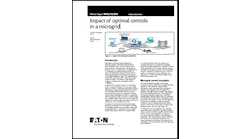Stephanie Pine, manager, federal business at S&C Electric, explores how the Department of Defense is approaching its energy resiliency goals. DoD microgrids are part of the strategy.
Stephanie Pine, manager, federal business, S&C Electric
Energy resiliency isn’t just an overarching long-term goal for the Department of Defense (DoD); it’s a critical competency with specific DoD requirements to ensure constant maintenance of operations crucial to national security. As a smart energy solution that can be custom-tailored to fit DoD-specific needs, microgrids present an excellent opportunity to meet DoD resiliency requirements while reaping the additional benefits of this cutting-edge technology.
Defined by both reliability and energy security, resilient solutions for the DoD must encompass the military industry’s many-faceted needs. Reliability requirements include not only the ability to meet demand and withstand interruptions, but also the ability to adapt to a changing environment caused by energy disruptions. Reliability for the DoD is focused on mission assurance and a readiness to provide and maintain energy for critical activities.
Such DoD energy-security stipulations outline the necessity for ensured access to reliable energy supplies and the ability to protect and deliver energy to mission-critical loads. Further, resiliency measures often include specific requirements relating to the length of time critical loads must be sustained if an outage occurs. For the U.S. Army, this is a minimum of 14 days — a daunting task for most resiliency solutions.
Controls: The most critical component of DoD microgrids
With these energy resiliency requirements in mind, microgrids not surprisingly are being positioned as solutions that can meet the DoD’s expectations. However, to maximize the benefits provided by a microgrid and fulfill DoD requirements, a multitude of other standards pertaining specifically to the microgrid’s controls must be considered. Microgrid controls designed to support these energy resiliency requirements should:
- Include a “do-no-harm” approach
- Integrate a variety of methods for communicating with the equipment
- Have no single point of failure
- Offer contingency handling
As one of the operational expectations for DoD microgrids, “do no harm” mandates that the microgrid control system be capable of integrating existing assets and not adversely affect day-to-day operations. Integrating with legacy assets poses an additional challenge: The controls must support multiple communication protocols, including Modbus, CANbus, DNP3, and BacNet, to allow optimization across a variety of distributed energy resources.
Communication methods aside, microgrid control systems for the DoD must recognize and automatically adjust to unexpected conditions. Microgrid controls must be able to both withstand power and communication interruptions and successfully adapt to the environment created by energy disruptions, DER failures, and changing energy needs.
The ability to manage contingencies is an important element of a resilient microgrid and is closely linked to the need to eliminate single points of failure within the system. As a high-profile target for both physical and cyber attacks, a DoD microgrid control system without a distributed control architecture can pose serious risks of cascading failures associated with an intrusion.
Though this litany of requirements may seem unachievable, commercially available microgrid controllers can satisfy all these needs and already have been successfully implemented in both federal and commercial spaces. Camp H.M. Smith, a Marine Corps base in Hawaii, was the final deployment of a three-phase project across multiple military bases meant to integrate microgrids into the federal sphere. On the commercial front, Ameren Illinois, a regulated utility, implemented a microgrid system with 16 use cases to improve reliability and resiliency, and the utility is using the microgrid to conduct research for future endeavors. Though microgrids may still seem like new, untested solutions, multiple case studies have shown that with the right controls, a microgrid can effectively fulfill DoD requirements.
Communication methods aside, microgrid control systems for the DoD must recognize and automatically adjust to unexpected conditions.
Cybersecurity for DoD microgrid controls
Looking beyond energy-resiliency requirements, microgrids for the DoD must also be able to adapt to changing cybersecurity technologies and update over time as technology continues to advance—without harming the integrity of the system. Any deployed microgrid control system will need to meet standards established as part of the Risk Management Framework to achieve an Authorization to Operate (ATO). An ATO is the DoD’s highest credential given to technology that meets its rigorous cybersecurity requirements and is an arduous task to successfully execute — so difficult, in fact, only one available microgrid control system has received this accreditation: the GridMaster Microgrid Control System.
As an ever-evolving component of any resiliency-focused solution, staying up to date on cybersecurity requirements must be a collaboration between multiple parties. The system operator, system owner, and service provider must all be aware of, and be in agreement on, who will oversee the long-term tracking of changes in these requirements and implement system updates to adhere to shifting standards. Without this collaboration, the system’s preexisting cybersecurity measures are likely to become outdated, exposing the microgrid to a cyberattack.
There is an art to balancing cybersecurity and system usability. Collaboration among the various players is a key step in maintaining a cybersecure microgrid. Cybersecurity technology and requirements are changing rapidly and require continuing investments to ensure military systems remain safe, efficient, and in adherence with DoD requirements. Without an understanding of this critical competency and the continuous monitoring and updates control systems require, the initial investment of implementing a microgrid can be for naught.
As DoD energy resiliency requirements remain rigorous and expectations for reliable energy continue to rise, advanced microgrids will remain a viable solution for those in search of a resilient military-grade energy solution.
Stephanie Pine is manager of federal business for S&C Electric.







